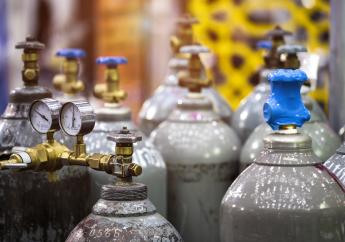A safety alert has been issued regarding the discovery of asbestos in Chinese manufactured acetylene cylinders that have been imported into Australia.
Recent testing identified asbestos within the internal insulation (porous mass) of acetylene cylinders that are commonly used in Australian mining operation workshops. The cylinders were reportedly manufactured and supplied by companies based in China to Australian businesses.
Information supplied to AMSJ indicated that the Australian importer received information from the China-based supplier that the product did not contain asbestos or asbestos-containing materials. While batch testing was conducted in China and an asbestos-free certificate issued, other batches tested in 2020 through a registered National Association of Testing Authorities (NATA) laboratory In Australia and were found to contain chrysotile (white) asbestos.
Investigations have revealed that asbestos can sometimes be in the porous mass and the neck and base of the cylinder. It is not clear if the asbestos can be liberated from the masses inside the cylinder and travel into the flame path of oxy-acetylene torches. While it is expected the material should not liberate in most circumstances, AMSJ would recommend that independent regulatory authorities be contacted to validate exposure risks.
What should mines do?
At the first instance, AMSJ recommends that mining companies should contact suppliers to confirm that imported cylinder do not contain asbestos. Many importers have identified the issue and began to recall affected cylinders, however, we would recommend that any test certificates supplied by suppliers be validated by a third-party accredited laboratory that has accreditation in Polarized Light Microscopy techniques for the identification of asbestos.
Under no circumstance should mines perform any maintenance, repairs or modifications on these cylinders.
Specifically requirements are detailed below
Importers must ensure they do not import asbestos into Australia. They should be aware of the varying definitions and standards applied in the country of origin and/or supply. Australian regulations apply at the border. Commercial importers of these cylinders should apply a risk management process for asbestos to their supply chain/s.
When cylinders of risk for asbestos are identified, the Australian Border Force will require assurance from the importer, in the form of documentary evidence, that the acetylene cylinders do not contain asbestos. A test report from a NATA accredited laboratory (or equivalent international laboratory) showing no detectable asbestos is the best form of assurance. If adequate assurance is not provided, suppliers will face delays and be responsible for costs incurred when the cylinders are held at the border for the purposes of sampling and testing.
If empty acetylene cylinders containing asbestos cannot be returned to the Australian supplier for replacement, they should not be disposed of unless they are taken to a licensed facility that handles hazardous waste. Further information on the disposal of asbestos waste may be obtained from local government authorities, the relevant environmental protection authority or waste disposal authority in your state or territory. Used cylinders must not be cut open or their structural integrity compromised, unless under the direction of an asbestos professional.
This latest incident is not the first time that asbestos has been detected in the acetylene cylinder. In 2017 Chinese company Chinese Xinxiang Safety Cylinder supplied a number of the cylinder to Australian companies containing asbestos.
